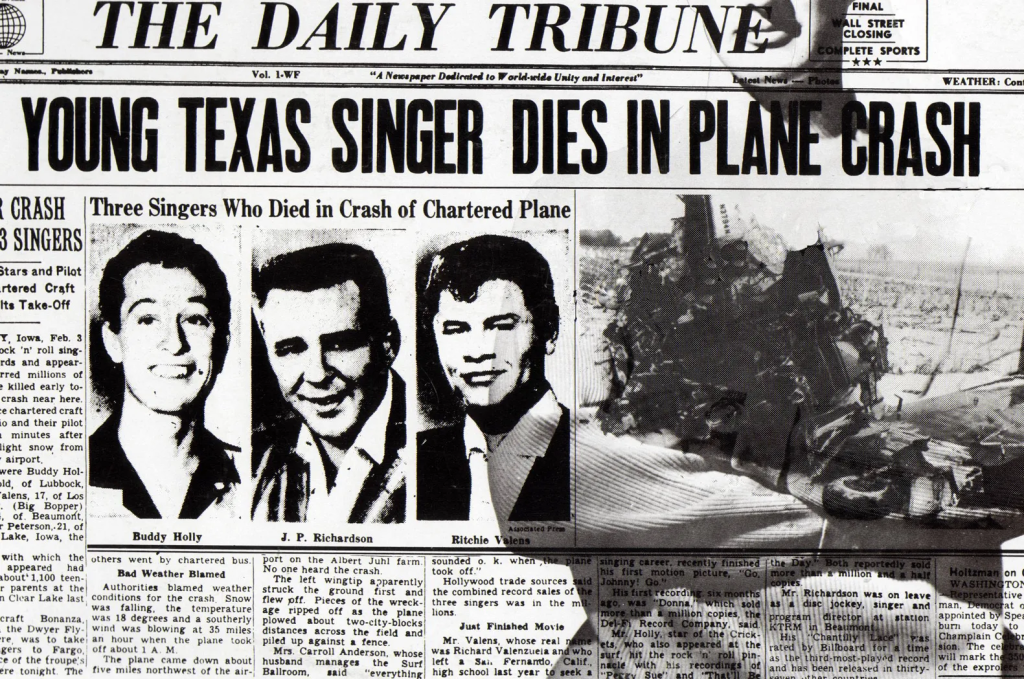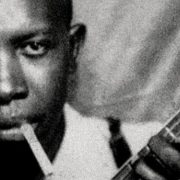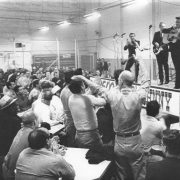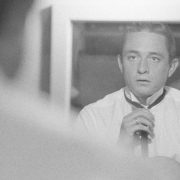
On the fateful night of February 3, 1959, the world of music was shaken to its core as news spread of a tragic plane crash near Clear Lake, Iowa. Among the victims was one of rock and roll’s brightest stars, Buddy Holly. At just 22 years old, Holly had already left an indelible mark on the music industry with his innovative sound and catchy tunes. His untimely death not only robbed the world of a talented musician but also marked the end of an era and left a void that would be felt for years to come.
Buddy Holly’s journey to fame began in the late 1950s when he burst onto the music scene with a string of hits that showcased his unique blend of rockabilly, country, and rhythm and blues. With his distinctive glasses, charismatic stage presence, and infectious energy, Holly quickly became a household name, capturing the hearts of fans around the world.
At the height of his career, Holly embarked on a nationwide tour known as the “Winter Dance Party,” which also featured fellow musicians Ritchie Valens and J.P. “The Big Bopper” Richardson. The tour was grueling, with long drives between venues and subpar living conditions taking a toll on the performers’ health and morale. Frustrated with the constant hardships, Holly made the fateful decision to charter a plane to the next tour stop in Moorhead, Minnesota, in hopes of getting some much-needed rest and avoiding another long bus journey.
Tragically, the small chartered plane, piloted by Roger Peterson, never made it to its destination. Just minutes after takeoff, the aircraft crashed into a snow-covered field, killing all four occupants instantly. The news sent shockwaves through the music world, leaving fans and fellow musicians in disbelief and mourning the loss of three talented artists.

The aftermath of the crash was profound and far-reaching. The music industry mourned the loss of three promising talents, each of whom had left an indelible mark on rock and roll. Buddy Holly, in particular, was hailed as a pioneer whose influence would be felt for generations to come. His innovative approach to songwriting and recording techniques paved the way for countless artists who followed in his footsteps.
In the years that followed, Buddy Holly’s legacy only grew stronger. His music continued to resonate with audiences of all ages, earning him a place in the Rock and Roll Hall of Fame and cementing his status as one of the greatest musicians of all time. Countless tribute albums, concerts, and documentaries have honored his memory, ensuring that his contributions to music will never be forgotten.
The tragic plane crash that claimed Buddy Holly’s life remains one of the darkest moments in music history. Yet, amidst the grief and sorrow, there is also a sense of reverence and appreciation for the incredible talent that was lost that night. Buddy Holly may have been taken from us far too soon, but his music lives on, serving as a timeless reminder of the power of rock and roll to inspire, uplift, and unite us all.
In conclusion, the tragic plane crash that ended Buddy Holly’s promising career was a devastating blow to the music world. Yet, even in death, Holly’s legacy endures, a testament to the enduring power of his music and the impact he had on generations of artists and fans alike. Though he may be gone, Buddy Holly’s spirit lives on in the hearts and minds of all who continue to be touched by his timeless melodies and infectious energy.









I am not positive where you are getting your info, however good topic I needs to spend some time learning much more or understanding more Thank you for excellent information I used to be looking for this information for my mission
Real instructive and excellent structure of written content, now that’s user genial (:.
Hey there! This is kind of off topic but I need some help from an established blog. Is it very hard to set up your own blog? I’m not very techincal but I can figure things out pretty fast. I’m thinking about setting up my own but I’m not sure where to begin. Do you have any ideas or suggestions? Many thanks
Your style is so unique compared to many other people. Thank you for publishing when you have the opportunity,Guess I will just make this bookmarked.2
Keep up the wonderful work, I read few blog posts on this website and I conceive that your weblog is real interesting and has lots of wonderful info .
Heya i am for the first time here. I came across this board and I find It truly helpful & it helped me out much. I’m hoping to present one thing back and aid others like you helped me.
Terrific paintings! This is the kind of information that are meant to be shared across the web. Shame on the search engines for not positioning this publish upper! Come on over and seek advice from my website . Thank you =)
I enjoy the efforts you have put in this, thanks for all the great blog posts.
Attractive section of content. I just stumbled upon your site and in accession capital to assert that I acquire in fact enjoyed account your blog posts. Anyway I will be subscribing to your feeds and even I achievement you access consistently rapidly.
Hi, Neat post. There’s a problem together with your site in web explorer, would test thisK IE nonetheless is the market chief and a huge component of folks will miss your excellent writing due to this problem.
It’s awesome designed for me to have a web page, which is helpful in support oof my knowledge.
thanks admin
Feel free to visit my web site … Supportvavada.Populiser.com
I enjoy your piece of work, regards for all the useful content.
Центр ментального здоровья — это место , где заботятся о вашем разуме .
В нем трудятся профессионалы, стремящиеся помочь в сложные моменты.
Задача учреждения — восстановить эмоциональное равновесие клиентов.
Услуги включают консультации для решения проблем и тревог .
Такой центр обеспечивает комфортную атмосферу для развития.
Посещение центра — шаг к здоровью и лучшей жизни .
https://serjiujitsu.com.br/2023/08/
It’s really a great and useful piece of info. I’m satisfied that you shared this useful information with us. Please keep us informed like this. Thank you for sharing.
This online pharmacy features a broad selection of medications at affordable prices.
You can find both prescription and over-the-counter medicines for all health requirements.
We strive to maintain high-quality products without breaking the bank.
Speedy and secure shipping guarantees that your purchase gets to you quickly.
Take advantage of shopping online with us.
https://podcastindex.org/podcast/6823070
Жителю мегаполиса важно быть в курсе модными трендами. Сегодня имидж становится визитной карточкой. Правильно подобранный образ помогает выделиться из толпы. К тому же, тренды часто связаны с актуальными событиями. Регулярно обновляя гардероб, легче адаптироваться к любым ситуациям. Посещая показы мод или читая журналы, легко найти свой уникальный стиль. Таким образом, модные тренды позволяют идти в ногу со временем.
https://www.fraternalorderofmoai.org/huimalu2/viewtopic.php?t=26863193
Magnificent site. Plenty of helpful info here. I am sending it to some friends ans additionally sharing in delicious. And naturally, thanks on your effort!
You made several fine points there. I did a search on the issue and found most folks will have the same opinion with your blog.
Great goods from you, man. I’ve understand your stuff previous to and you’re just extremely magnificent. I really like what you have acquired here, really like what you are stating and the way in which you say it. You make it enjoyable and you still care for to keep it smart. I can not wait to read far more from you. This is actually a great website.
It¦s in reality a nice and useful piece of information. I¦m happy that you shared this useful information with us. Please keep us up to date like this. Thanks for sharing.
Our e-pharmacy offers a broad selection of health products with competitive pricing.
Shoppers will encounter all types of medicines suitable for different health conditions.
We strive to maintain trusted brands at a reasonable cost.
Fast and reliable shipping ensures that your order arrives on time.
Experience the convenience of ordering medications online through our service.
https://guessto.com/priligy-in-the-usa-what-you-need-to-know/
The digital drugstore provides a wide range of medications for budget-friendly costs.
Shoppers will encounter both prescription and over-the-counter remedies suitable for different health conditions.
We strive to maintain safe and effective medications without breaking the bank.
Speedy and secure shipping ensures that your order arrives on time.
Take advantage of shopping online on our platform.
https://www.apsense.com/article/834919-kamagra-oral-jelly-online-how-to-buy-safely-without-risks.html
Hello there, just became aware of your blog through
Google,and found that it’s truly informative. I amm going to
watych out for brussels. I will be grateful
if you continue this in future. Many people will be bnefited from your writing.
Cheers!
my web-site :: http://www.Depaddock.eu/forum/member.php?u=34006
Greetings! This is myy first visi to yoyr blog!
We are a group of volunteers and starting a new initiative
in a community in the same niche. Your blog provided us beneficial informatin to work
on. You have done a marvellous job!
Here is my web site http://forum.Gokickoff.com/index.php?action=profile;u=20375
Hello to every body, it’s my first pay a visit of this weblog; this
blog consists of remarkable and in fact good ddata in support of readers.
Here is myy homepage – http://Www.ts-gaminggroup.com/member.php?350869-Serzzpr